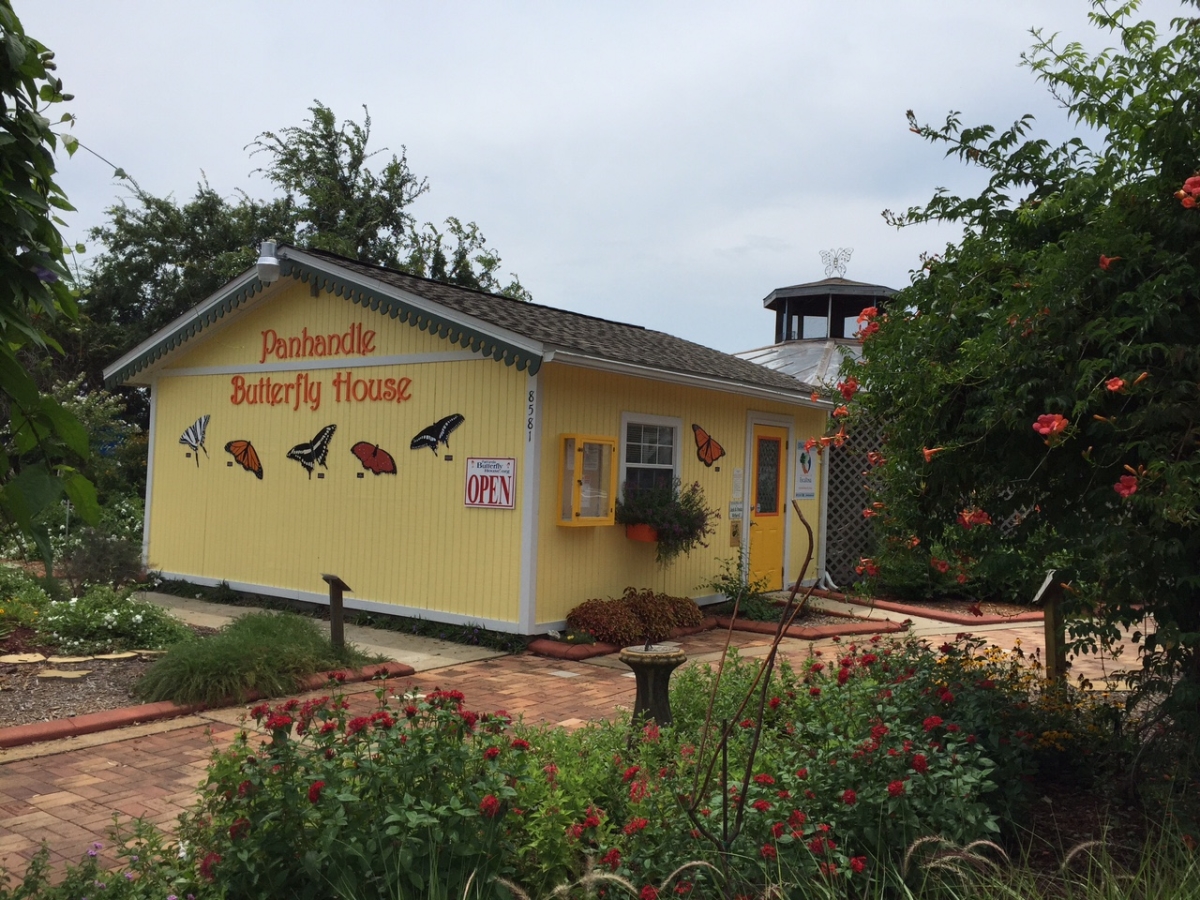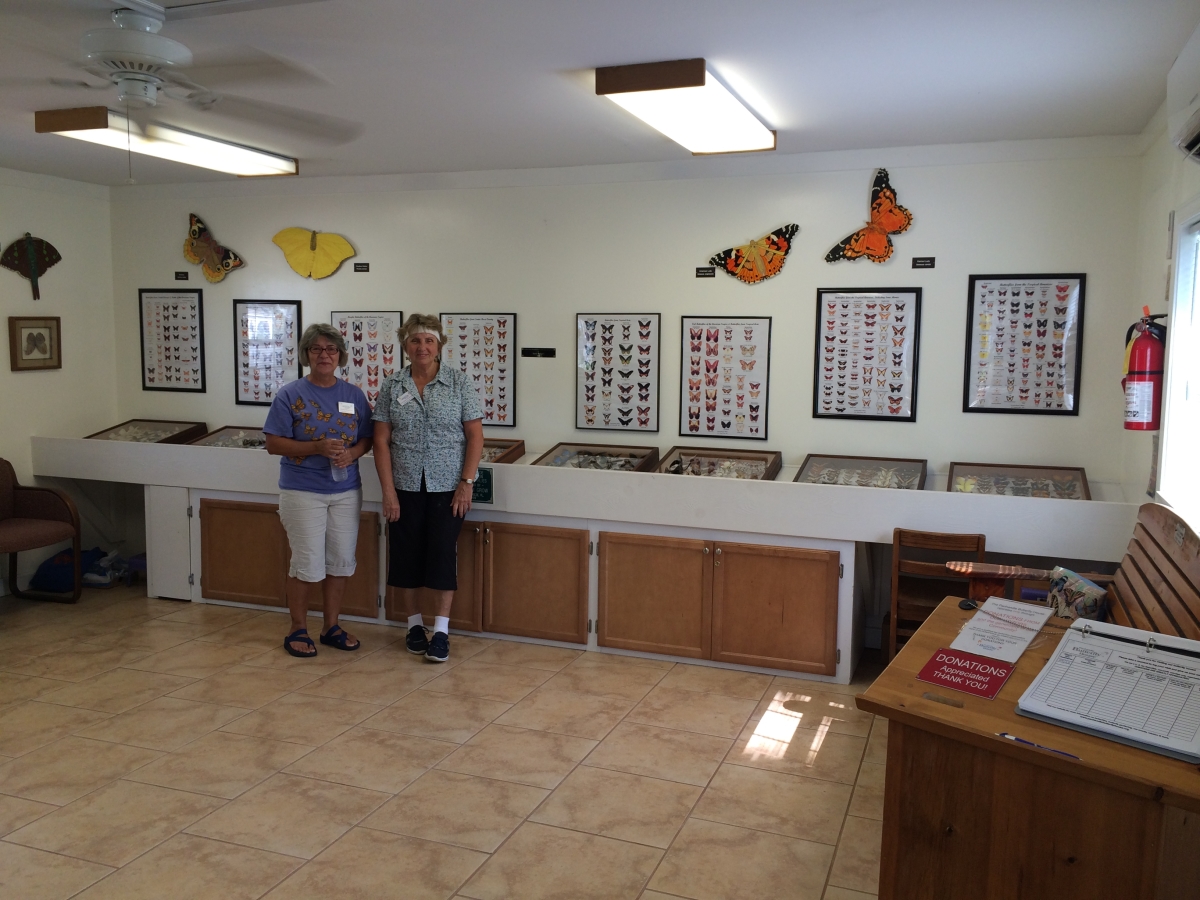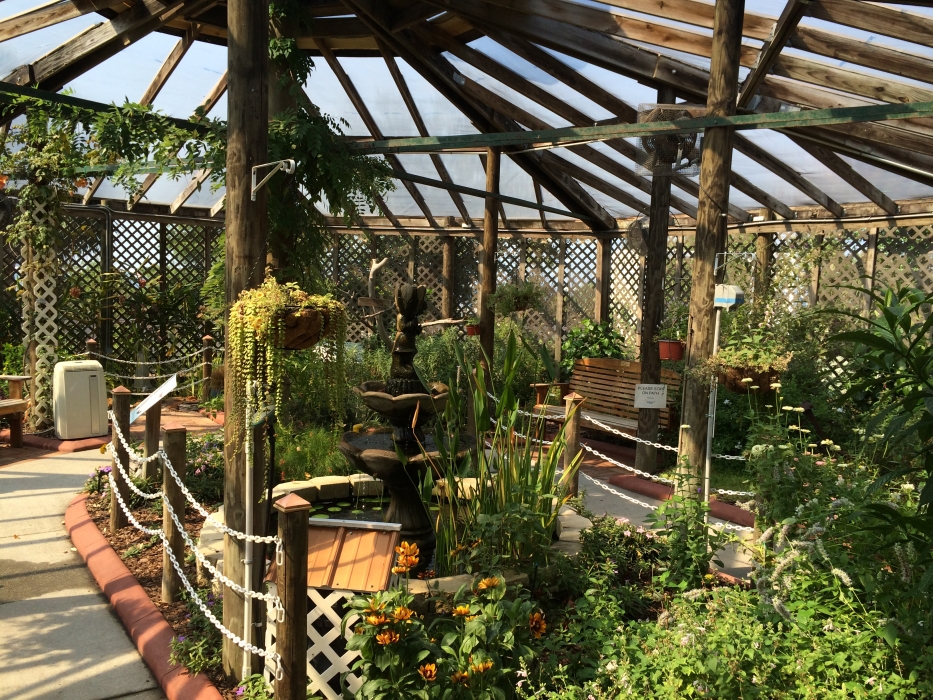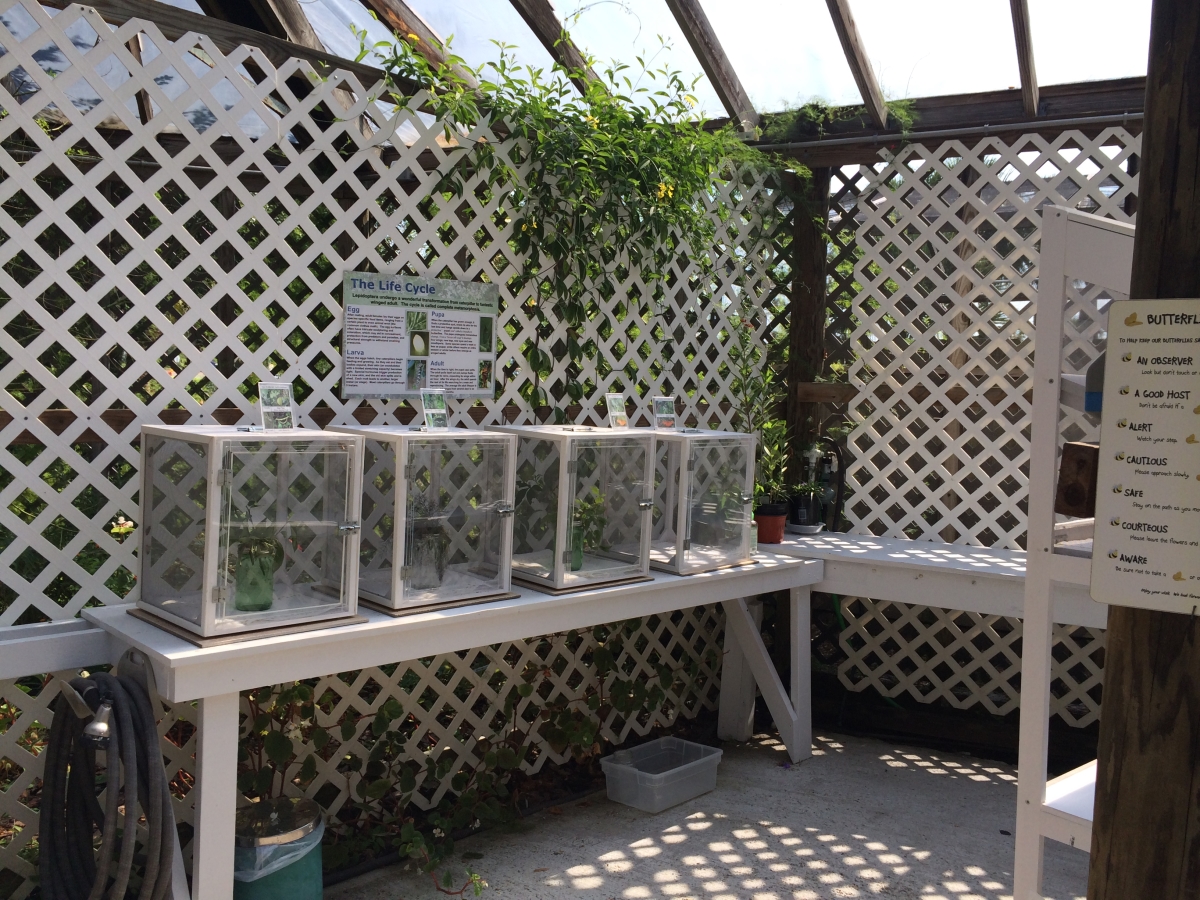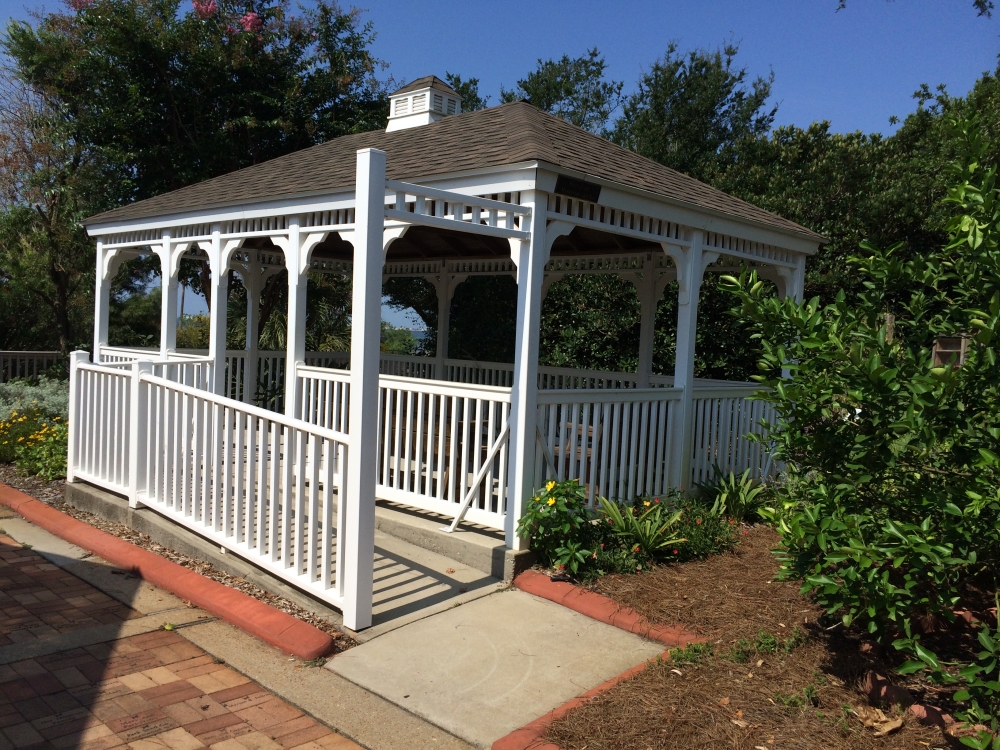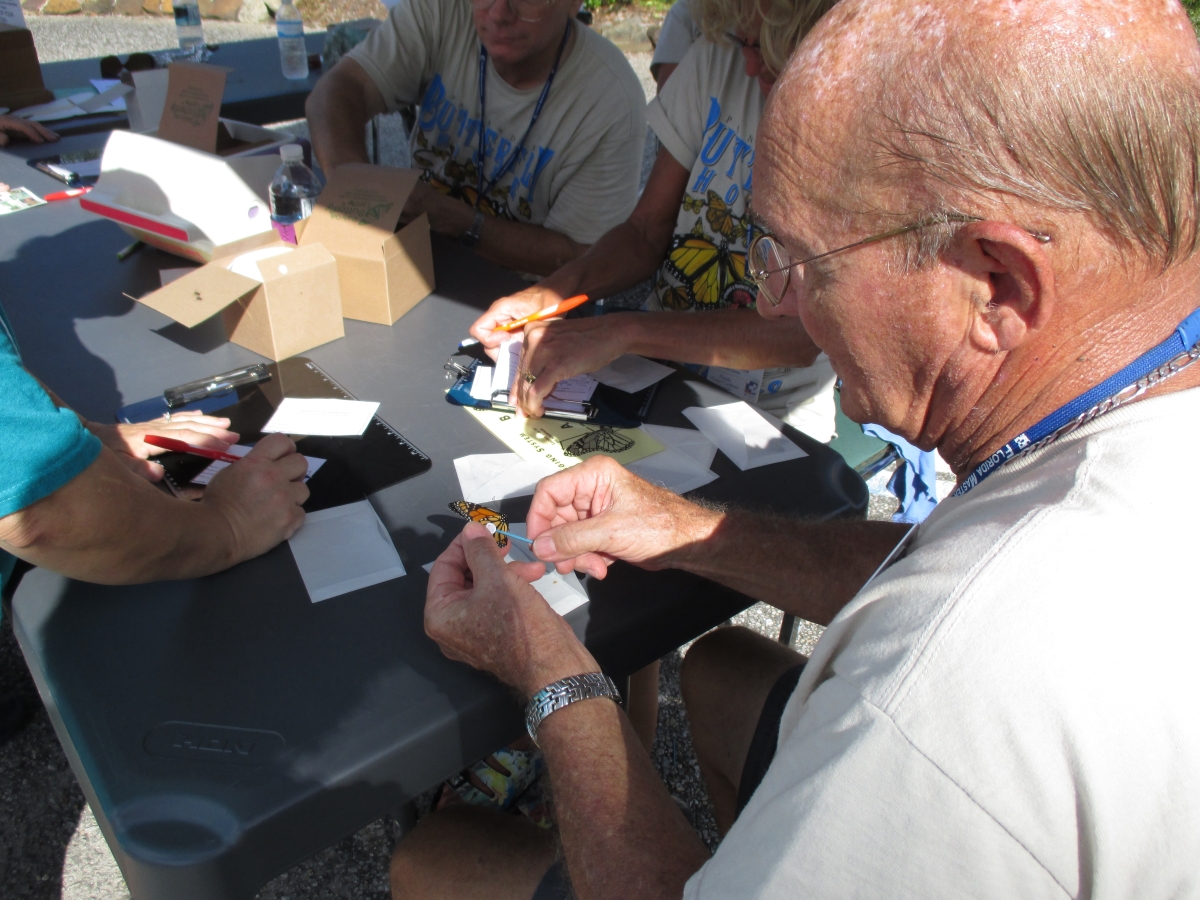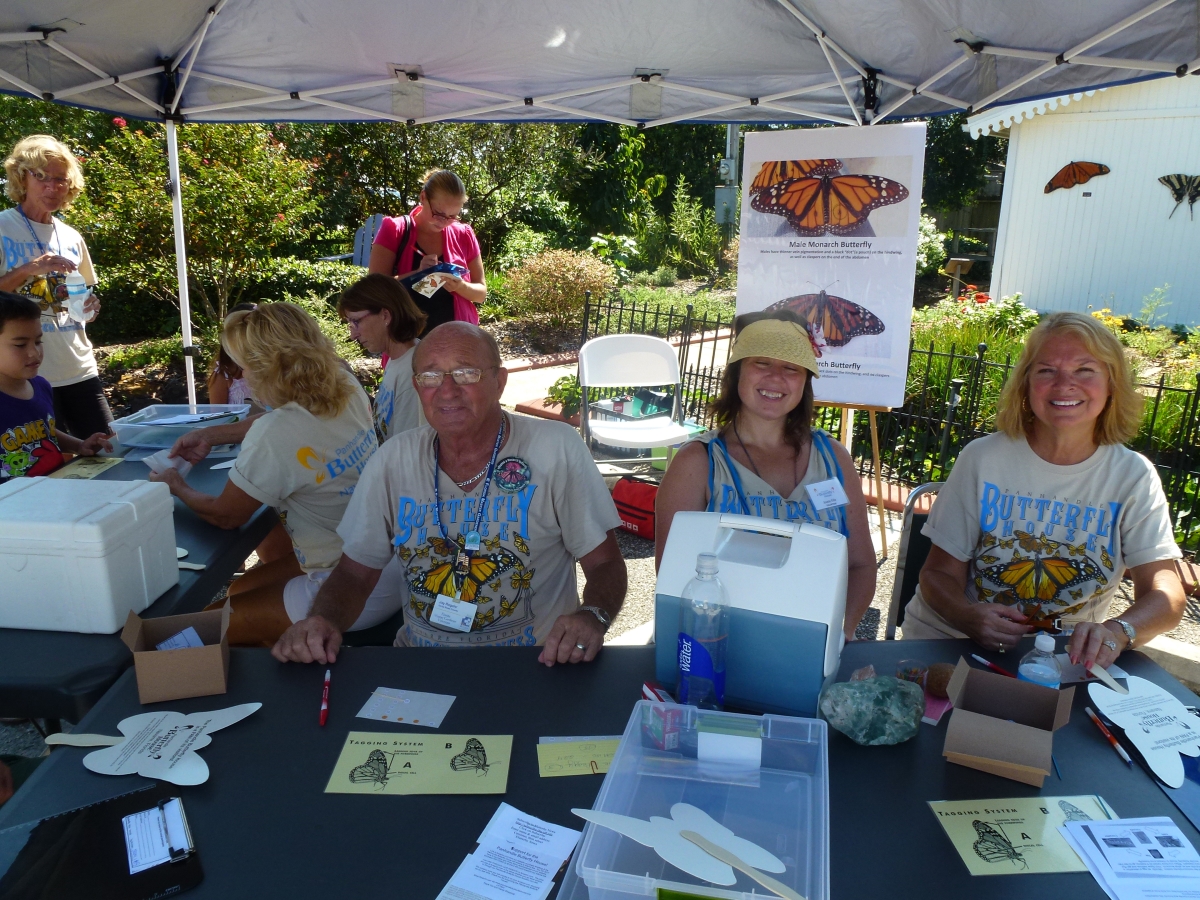Journal of the NACAA
ISSN 2158-9429
Volume 8, Issue 2 - December, 2015
The Panhandle Butterfly House Expands Environmental Awareness
- Derrick, M. L., Residential Horticulture Agent, UF/IFAS Extension Santa Rosa County
ABSTRACT
UF/IFAS Extension partners with a local Keep America Beautiful affiliate in coordinating the Panhandle Butterfly House (PBH) in Navarre, Florida. The PBH displays live native butterflies in all life stages with appropriate nectar and host plants with the mission of educating the public on the biology and environmental significance of butterflies and other pollinators. Florida Master Gardeners and community volunteers from three counties run all operations, volunteering 5145.5 hours in 2014. A total of 12,901 people from 48 states and 18 different countries visited in 2014. In 2014, 1065 youth participated in educational guided tours.
Introduction
Extension professionals have opportunities to originate or be involved in one-of-a-kind educational programs in their local areas. Partnerships with other organizations and participation by volunteers can make for dynamic and innovative programming. Collaboration by Extension with other non-profits that have similar visions contributes to the success of its goals (Strieter, 2006; Ehmke, 2007). Participation by volunteers are crucial partners as Extension has limited time and resources (Whitelaw, Vaughan, Craig, & Atkinson, 2004). Such is the case with the program for increasing the awareness and appreciation for native Florida butterflies that is operated as the Panhandle Butterfly House.
The educational opportunities of butterfly houses have great potential to raise public awareness of the need for conservation of butterflies and environmental issues in general (Boppre, 2012). In addition to being open to the public on certain days and times, the Panhandle Butterfly House serves as an outdoor science classroom for local schoolchildren on field trips, home school groups and other organizations that serve children. Outdoor classrooms are effective tools for teaching science curriculum and fostering interest in the environment (Flannery, 2006). Children are drawn to learning about butterflies and this learning has the potential to engage them in science for the long haul (Chen, 2013).
Overview of the Program
The Panhandle Butterfly House (PBH) is located in Navarre, Florida, at the foot of the Navarre Beach Bridge. It is situated in the Navarre County Park on the shores of scenic Santa Rosa Sound. Within the park there is also a nature walk, children’s water park, playground, picnic areas, a tourist visitor center, and an upcoming kayak launch site.
Figure 1. The front of the Panhandle Butterfly House with main entrance on the right; the vivarium visible in the back of the structure.
When visitors arrive, they first encounter the outdoor butterfly gardens surrounding the butterfly house. All plants are either nectar plants for the adults or host plants for the caterpillars. The landscaping is mature, lush, very well thought out and meticulously maintained. Signage is present for many plants indicating the species and its role in butterfly gardening.
Stepping inside the building, the visitor enters a climate controlled one-room permanent structure and is welcomed by a docent who records the numbers of adult and youth visitors. This room houses a small gift shop and a preserved butterfly collection. The gift shop offers inexpensive butterfly related items such as t-shirts, books, and children’s activity items. The permanent butterfly collection displays 300 species of butterflies from around the world collected and donated by a local butterfly aficionado. Docents provide a brief introduction to the exhibits and then guide visitors through doors to the vivarium (screened butterfly enclosure) which houses the live butterflies. The vivarium contains butterfly gardens, two ponds (one with fish) and a bird bath that acts as an artificial puddle for butterflies. A teaching nursery in the vivarium houses caterpillars with their larval host plants in acrylic cases and chrysalises hanging in a separate case.
Figure 2. Volunteer docents interpret the collection of 300 butterflies from around the world.
Approximately 120 butterflies are purchased from a certified Florida butterfly farm on a weekly basis, and they are released each Wednesday into the vivarium. All butterflies in the vivarium are native to Florida; this allows local visitors to learn about butterflies they may encounter in their own landscapes or in natural areas. Since the butterflies are all native, the butterflies are allowed to breed in the house, and thus, the entire lifecycle can be viewed. Often visitors can view female adult butterflies laying their eggs on host plants.
Figure 3. Interior of the vivarium.
Numerous native and Florida-friendly plants inhabit the indoor and outdoor gardens that serve as nectar plants for adult butterflies and as host plants for the caterpillars. Visitors learn about these gardening concepts and how to adopt them in their own landscapes or appreciate them in natural areas. No pesticides are used in the operation and visitors learn how to maintain a garden without their use in order to protect our pollinators. Awareness and protection of our pollinators is critical to our ecology, as the inappropriate use of pesticides have been implicated in the loss of honey bees that pollinate many of our essential food crops.
The Panhandle Butterfly House is a unique exhibit as there is no other butterfly house in the region. There are only 6 butterfly houses in all of Florida; there are no others in the panhandle, with the closest one in Florida being in Gainesville. The closest butterfly houses to the north are in Pine Mountain, Georgia and in Huntsville, Alabama, and to the west in New Orleans, Louisiana. The Panhandle Butterfly House is unique in the state and region as it is the only one that houses only native butterflies and, thus, allows them to breed. Visitors encounter and learn about all stages of the butterfly lifecycle: egg, caterpillar, chrysalis, and adult. Other butterfly houses that exhibit exotic butterflies are not allowed to let them breed.
Figure 4. Larvae display cases inside the vivarium.
The PBH has no admission fee; this allows low and moderate-income individuals and families to take advantage of the exhibit. Signage in the facility indicates that we take donations. As a primarily educational facility, we look to attract a diverse population in terms of age, gender, ethnicity, income level and other backgrounds.
The facility and grounds are wheelchair accessible in order to serve those with limitations. The site includes a gazebo that is used extensively for outside education, a shade house for growing butterfly host and nectar plants, and a tool shed.
Figure 5. The gazebo in the outdoor butterfly garden is enjoyed by casual observers as well as tour groups.
The PBH opens seasonally from the first Saturday in May until the last Saturday in August. It is open to the public Thursday through Saturday, from 10 am until 3 pm CST. Monday through Wednesday it is available by reservation to groups for private tours. The majority of tour groups are composed of youth from schools, clubs and homeschoolers. Tours are also popular with civic and social groups. The curriculum for all tours meet the Sunshine State Standards for Florida public school systems and Florida Literacy standards.
Monarch Madness has been a special event in October since 2007. This event celebrates the extraordinary monarch migration to Mexico every fall. Over 2,000 visitors attend a two-day festival and learn about the uniqueness of the monarch butterfly through hands-on activities and displays. Five hundred monarch butterflies are tagged and released by visitors after receiving specific training by volunteers. The tagging is coordinated through Monarch Watch, a non-profit organization based at the University of Kansas that studies the migratory patterns and biology of the monarch. The PBH has been certified as a Monarch Waystation that creates, conserves, and protects milkweed and monarch habitats.
According to Dr. Chip Taylor of the University of Kansas Monarch Watch Program, the tagging of monarch butterflies in the autumn contributes greatly to the research in monarch migration. The involvement of thousands of taggers across the country has created a veritable army of observers in the field. The tagging provides researchers with insights on the dynamics of the migration and the size and quality of the population each season. The annual Monarch Madness event brings over 2,000 people into intimate contact with one of the world’s most remarkable natural events each fall. When visitors become familiar with monarch biology, the information gleaned enhances their appreciation for preserving the monarch migration in North America.
Figure 6. Tagging monarch butterflies during the October Monarch Madness festival.
In addition to the two-day festival, scheduled tours are available the week before and the week after the festival. These tours focus on the monarch butterfly and are very popular with local elementary school teachers for their students. Many local elementary schools and home school groups rely on the PBH for quality science-based learning in what is known as “Kiderpillar School”.
Monarch Madness has joined a larger event in recent years, the Beaches to Woodland Tour of Santa Rosa County, sponsored by the Santa Rosa County Tourist Development Council. The Beaches to Woodlands Tour highlights ecotourism events throughout the county during the month of October.
History
In 1996 the Navarre Chamber of Commerce created a Nature Walk at the Navarre County Park. The park is situated on scenic Santa Rosa Sound next to the causeway bridge to Santa Rosa Island, the barrier island along the coast. A local couple, Jack and Fonda Wetherell, persuaded the Santa Rosa Board of County Commissioners and the Chamber of Commerce to allow them to add a butterfly house on the site. The butterfly house began under the oversight of Santa Rosa Clean Community System (SRCCS), the local Keep America Beautiful affiliate.
Donations and labor for construction and operation came from residents, businesses and garden clubs. From inception, Florida Master Gardeners from a three-county area volunteered their time planning, building and maintaining the butterfly house. The University of Florida Milton campus donated 1,000 plants. The doors opened on Memorial Day, 1997. Operations were run informally by the Wetherells and volunteers with the guidance of SRCCS and the University of Florida/Institute of Food and Agricultural Sciences (UF/IFAS) Extension Santa Rosa horticulture agent.
After hurricanes struck the area in 2004 and 2005, the PBH was rebuilt and expanded to the structure it is today. In 2006, a Board was organized to run the operation.
Organizational Structure of the Panhandle Butterfly House
The PBH is a joint program of UF/IFAS Extension and SRCCS and is governed by a Memorandum of Agreement between the parties. SRCCS is an ongoing 501(c) 3 non-profit local affiliate of Keep America Beautiful with the mission of protecting the environment through education, awareness and action. The finances of the butterfly house are under the purview of SRCCS although they maintain completely separate bank accounts and funding sources. UF/IFAS Extension serves the role of scientific and operational advisor and outreach coordinator to the butterfly house.
The Board manages the operations of the PBH. All positions are filled by volunteers, except that of the Horticulture Extension Agent from UF/IFAS Extension Santa Rosa County and the Executive Director of SRCCS, who serve as non-voting advisors.
Role of Florida Master Gardeners and Community Volunteers
All positions in the operation of the PBH are filled by Florida Master Gardener volunteers from Santa Rosa, Escambia and Okaloosa counties, and other community volunteers. This team of approximately 75 volunteers serve as leaders, docents, tour guides, sales, gardeners, maintenance, publicity, and newsletter staff (See Table 1 for detailed data from 2014).
|
Volunteer Category |
Master Gardeners | Community Volunteers | Total Hours |
|---|---|---|---|
| Leadership | 2149.75 | 640 | 2790 |
| Docents | 544.75 | 511.5 | 1056.25 |
| Gift Shop | 13.5 | 322.5 | 336 |
| Gardeners | 531 | 93.25 | 624.25 |
| Tour Guides | 89.5 | 218.75 | 308.25 |
| Misc. | 31 | 0 | 31 |
| Total | 3359.5 | 1786 | 5145.5 |
Table 1. Panhandle Butterfly House Volunteer Hours 2014
The University of Florida values trained volunteers at $21.24 per hour. The calculation of the economic value of trained volunteers’ contribution to extension programs is obtained from the 2013 Florida data from the Independent Sector (http://independentsector.org/volunteer_time.html).
In 2014, volunteers contributed 5145.5 volunteer hours to the operation of the Panhandle Butterfly House. This translates to an economic benefit to the community from the volunteers of $109,290 in 2014.
Figure 7. Knowledgeable and enthusiastic Master Gardeners coordinate tagging operations at Monarch Madness festival.
Impacts
The educational and environmental awareness impact on visitors is significant. Visitors learn about:
- Species of butterflies native to Florida
- All four life stages (egg, caterpillar, chrysalis, and adult)
- Importance of butterflies in maintaining a healthy, productive environment
- Butterflies, like bees, are major pollinators of crops and flowering plants in natural areas
- Butterflies serve as an important food source for birds, lizards, spiders, small mammals, and other insects
- Butterflies are very sensitive to changes in their environment, thus becoming good prognosticators of environmental health
- How to create a healthy butterfly habitat
- How pesticide use impacts butterflies and other pollinators
Assessment of knowledge gained is performed for the youth tour groups. Overall, in 2014, the knowledge gain was 81% averaged over the youth tour groups. The topics assessed were knowledge of beneficial insects, butterfly metamorphosis, and butterfly life cycles. It should be noted that some groups had classroom instruction on butterfly biology in preparation for the tour.
Assessment of knowledge gained and behavior change is not formally performed for all other visitors as it is not practical. Visitors arrive, linger and depart on their own schedule and, therefore, the atmosphere is not conducive to assessment of knowledge or behavior change. However, docents and tour guides report significant knowledge gained by the visitors through their experiences at the butterfly house. Also, repeat visitors have reported a greater awareness and appreciation for butterflies and the environment; some repeat visitors report that they added butterfly habitats to their home landscapes and have changed their landscape practices to benefit wildlife.
Volunteers consistently receive praises for the exhibit and special events. At the recent Monarch Madness festival in October 2015, a local mother of two young girls approached as she was leaving to thank us all for having this event. She exclaimed, “This is a one-of-a-kind place where I can bring my girls to learn so much about the beauty and wonder of butterflies and help develop their appreciation of the natural environment. I just cannot say how much we love the butterfly house.”
The PBH primarily serves the populations of three counties in the western panhandle of Florida: Santa Rosa, Escambia and Okaloosa Counties. However, tourists visit from other areas of Florida, most states and many other countries. In 2014 visitors reported coming from 48 states and 18 other countries. The facility is recognized as an important tourist attraction by both the Navarre Chamber of Commerce and the Santa Rosa County Tourist Development Council.
The table below (Table 2) summarizes the numbers of visitors for the years 2007 through 2014:
- Daily visitors are those visiting Thursday through Saturday during the season that generally starts the first of May through the end of August.
- Tours are pre-scheduled group visits that occur several weeks in April before the official opening, during the regular season Monday through Wednesday, and for the two weeks of the Monarch Madness celebration.
- The numbers in the Monarch Madness column are solely for the weekend event in October.
| Year | Adult Daily | Youth Daily | Adult Tour | Youth Tour | Monarch Madness | Total |
|---|---|---|---|---|---|---|
| 2007 | 3705 | 3196 | 184 | 241 | 2635 | 9960 |
| 2008 | 5778 | 4196 | 413 | 1002 | 2740 | 14,129 |
| 2009 | 6407 | 4143 | 723 | 777 | 2282 | 14,332 |
| 2010 | 4590 | 3654 | 364 | 827 | 2488 | 11,923 |
| 2011 | 5953 | 4679 | 549 | 1398 | 2528 | 15,107 |
| 2012 | 4685 | 3482 | 600 | 990 | 2849 | 12,606 |
| 2013 | 5894 | 4167 | 419 | 985 | 2095* | 13,560 |
| 2014 | 5549 | 4142 | 395 | 1065 | 1750* | 12,901 |
Table 2. Summary of visitors 2007 through 2014. *Storms during the festival in 2013 and 2014 significantly reduced attendance.
Visitor Data is collected and tracked by the categories of adult and child when an individual or group enters the building. Each visitor or group is asked to sign a logbook with their home address. The local category is defined as a resident of the tri-county area.
Communications
A website at www.panhandlebutterflyhouse.org is maintained and informs about location, hours, scheduling tours, donations, events and contacts. A Facebook page with 2,139 followers has three administrators that post regularly about events, daily happenings and links to research-based information on butterflies. A quarterly newsletter is sent to 2,890 subscribers through a UF/IFAS Extension subscription management system.
Grants
The Santa Rosa County Tourist Development Council awarded the PBH small grants of $1,500 in 2012 and 2013, $3,000 in 2014 and $4,000 in 2015 for the Monarch Madness event. Grants are being sought from other sources to include a RESTORE Act grant stemming from the 2010 Deepwater Horizon oil spill.
Donations and Other Funding Sources
Cash donations from daily visitors comprise the majority of funding. Tour groups are encouraged to donate at least $2.00 per person and many do. Patrons can purchase a custom engraved brick for $50.00 and have it placed in the adjoining walkway. Local businesses are solicited for monetary or in-kind donations. Donations in 2014 were approximately $19,400.
The gift shop sells inexpensive butterfly related items such as t-shirts, books and milkweed seed. Net income from these sales in 2014 was approximately $5,000. Occasional plant sales featuring nectar and host plants raise some additional income while providing an educational service on butterfly and pollinator gardening.
Challenges
As with most programs, there are challenges to overcome in order to maintain its health and vibrancy. The major challenges are:
- Recruiting volunteers to replace those who have moved or gone on to pursue other interests,
- Preventing burn-out in current volunteers, and
- While donations are adequate to fund normal operations, additional funding needs to be sought for major repairs like a new roof.
Awards
2009 - Search for Excellence National Winner in Landscape Horticulture from the National Association of County Agricultural Agents
2009 - Curtis Kingsbery Education Award for “increasing awareness of Florida’s biological diversity through the study of butterflies and their habitats” from the Francis M. Weston Audubon Society
2008 - Award of Excellence for Service to 4-H and other Youth for “Kiderpillar” School tour curriculum from the State of Florida Master Gardener Association
2004 – Award of Excellence for Educational Demonstration Gardens from the State of Florida Master Gardener Association
1998 – Special Achievement Award from the Florida Federation of Garden Clubs
1997 – Certificate of Special Achievement from the National Council of State Garden Clubs
Literature Cited
Boppre, M. (2012). The Butterfly House Industry: Conservation Risks and Education Opportunities. Conservation & Society, 10(3), 285-303.
Chen, JJ. (2013). Developing ‘Butterfly Warriors’: a Case Study of Science for Citizenship. Research in Science Education, 43 (6), 2153-2177.
Ehmke, C., & Mount, D. (2007). Reaching the Small Acreage Audience Through Collaboration: The Small Acreage Conservation Education and Outreach project. Journal of Extension [Online], 45(4) Article 4IAW3. Available at: http://www.joe.org/joe/2007august/iw3.php
Flannery, M. E. (2006). Seeds of Learning. NEA Today, 24(5), 32-33.
Strieter, L., & Blalock, L. (2006). Journey to successful collaborations. Journal of Extension [Online], 44(1) Article 1TOT4. Available at: www.joe.org/joe/2006february/tt4.shtml
Whitelaw, G., Vaughan, H., Craig, B., & Atkinson, D. (2003). Establishing the Canadian community monitoring network. Environmental Monitoring and Assessment, 88(1), 409-418.

